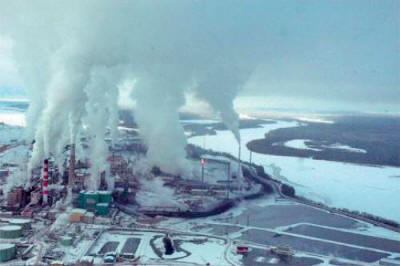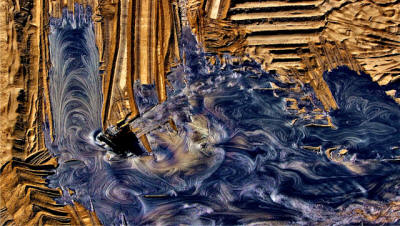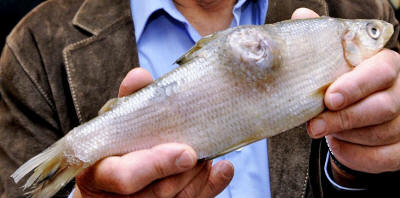|
Today federal scientists from Environment Canada presented research at an international toxicology conference in the U.S. that indicates contaminants from the Alberta tar sands are polluting the landscape on a scale much larger than previously thought.
A team lead by federal scientist Jane Kirk discovered contaminants in lakes as far as 100 kilometers away from tar sands operations.
The federal research confirms and expands upon the hotly contested findings of aquatic scientist David Schindler who, in 2010, found pollution from the tar sands accumulating on the landscape up to 50 kilometers away.
Senior scientist Derek Muir, who presented some of the findings at Wednesday's conference, said the contaminated region is,
The 'legacy' of chemicals in lake sediment gives evidence that tar sands pollution has been traveling long distances for decades.
Samples show the build up of polycyclic aromatic hydrocarbons, or
PAHs, known to
cause cancer in humans and to be toxic to aquatic animals,
in 6 remote and undisturbed lakes up to 100 kilometers away from
tar sands operations.
After the release of Schindler's groundbreaking research on tar sands pollution in 2010 the Alberta government claimed the 'contaminants were naturally occurring' and posed no risk to aquatic life.
However at today's conference, the annual meeting of the North American Society of Environmental Toxicology and Chemistry (SETAC), Kirk discussed the long list of 'priority pollutants' that accumulate in the region's snow.
Within 50 kilometers of the tar sands, snowpack contains numerous contaminants including dangerous neurotoxins, such as methyl mercury, that bioaccumulate in food webs.
Kirk found priority pollutants in the air were 1.5 to 13 times higher at test sites within 50 kilometers of tar sands refineries, and highest within 10 kilometers.
Abstracts for Kirk, Parrott and Muir's presentations can be found on pages 103 and 104 of the conference program.
The toxicity of melt water from snow falling in the tar sands region was researched by federal scientist Joanne Parrott, who also presented at the conference.
Studying snow samples taken in 2011 and 2012 along the Athabasca River, Parrott found that the melt water was toxic to minnow larvae, even when diluted down to 25 percent.
Parrott suggests melt water, once mixed with water from the Athabasca River, will no longer be toxic to minnows.
Snow melt, however, provides a significant amount of water to tributaries where fish hatch in the spring, says Schindler.
Parrott plans to expand her research to consider whether young fish in tributaries that feed the Athabasca River are affected by the pollution.
Schindler's research has already highlighted the increasing incidence of fish deformity in areas downstream of tar sands operations, like Lake Athabasca.
The scientists' presence at the conference is significant given the Harper government's strict control of scientific communications surrounding the tar sands.
Federal scientists were prevented from speaking with the media at the same conference in Boston last year.
An internal document uncovered by Postmedia instructed federal scientists to avoid answering media questions, saying,
After Postmedia's Mike De Souza released the internal document last week, Environment Canada made arrangements for the news agency to speak with both Muir and Parrott.
Postmedia's Margaret Munro explains:
As DeSmog covered in an earlier post, the Harper government's heavy-handed treatment of federal scientists led to a mass demonstration this summer, where scientists and academics mourned the "Death of Evidence," claiming "Stephen Harper Hates Science."
The government's strict communications policy is seen by some as an attempt to silence critics voicing science-based opposition to development of the tar sands.
Postmedia News November 7, 2012
from
TheProvince Website University of Alberta scientist David Schindler holds a whitefish with a tumor,
collected from
the Athabasca watershed, downstream from the oilsands industrial
development.
EDMONTON
Environment Canada scientists have confirmed
results published by researchers
from the
University of Alberta showing
contaminants accumulating in the snow near oilsands operations,
an internal federal document has revealed.
The original study, led by University of Alberta scientists Erin Kelly and David Schindler, analyzed winter snow and found that contamination levels were,
The document, which was attached to an email
indicating the information was also in the hands of the office
of Environment Minister Peter Kent, provided a scripted
list of answers that explained researchers had tested
the toxicity of the Athabasca
River water in the spring of 2010 with
negative results, and also that no link was established between
levels of contaminants found and any effect on fish.
The document also said that Environment Canada scientist Derek Muir, who was slated to attend the conference in Boston, and another senior department official, Dan Wicklum, would be allowed to answer questions from reporters,
Asked to comment on the Environment Canada document, Schindler welcomed the preliminary results, noting that some critics were,
But Schindler praised the federal scientists, Muir and Jane Kirk.
An Environment Canada spokesman, Mark
Johnson, said the scientists were not immediately available
for interviews, noting that answers to questions about the
research were included in the document.
from TheGlobeAndMail Website
A study set to be published on Monday has found elevated levels of mercury, lead and eleven other toxic elements in the oil sands' main fresh water source, the Athabasca River, refuting long-standing government and industry claims that water quality there hasn't been affected by oil sands development. The author of the study, University of Alberta biological scientist David Schindler, criticized the province and industry for an "absurd" system that obfuscates or fails to discover essential data about the river.
The Athabasca has increasingly become a flashpoint for debate.
Earlier this year, Environment Minister Jim Prentice dismissed Dr. Schindler's previous peer-reviewed work as "allegations." Oil surfaces naturally in the Athabasca and its tributaries as the river erodes the bitumen below it.
The government argues it is this, not industry, that is the main cause of the pollution.
He argues Dr. Schindler's conclusions don't accurately take that into account.
Mr. McEachern argued
government monitoring shows pollution hasn't significantly
increased in the Athabasca.
(An online Alberta government fact
sheet states "data indicates no increased concentration of
contaminants in surface water in the oil sands area.")
In winter, before a melt, only
levels of mercury, nickel and thallium were elevated near
industry
A RAMP spokesperson was unavailable Sunday.
Travis Davies, a spokesman for the Canadian Association of Petroleum Producers, insisted RAMP is,
Joe Obad, associate director of Alberta advocacy group Water Matters, called the study,
The Globe and Mail received a copy of the study from a third party.
References
|



